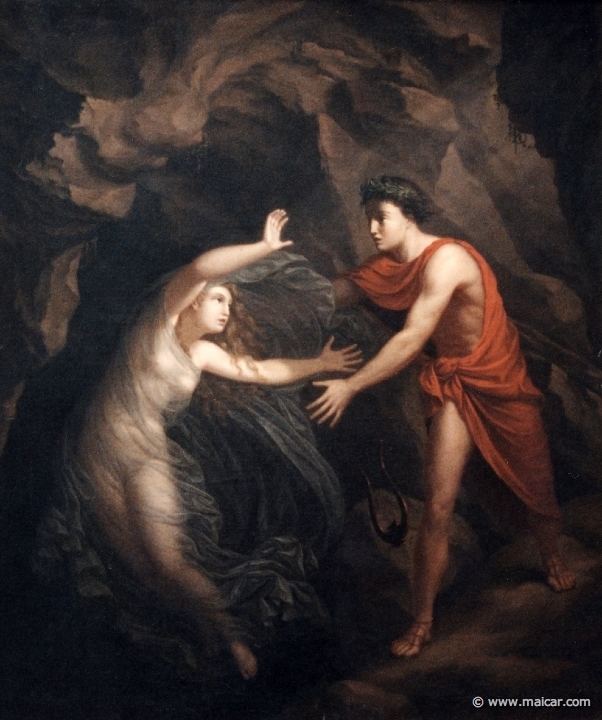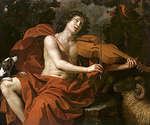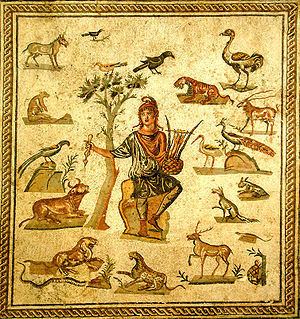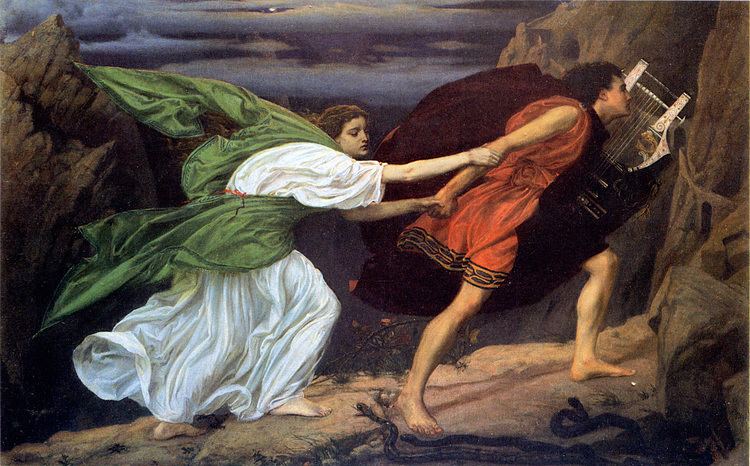Symbol Lyre | ||
 | ||
Siblings The Muses, the Graces, Linus Movies Black Orpheus, Orfeu, You Ain't Seen Nothin' Yet Played by Breno Mello, Lambert Wilson, Pierre Arditi, Toni Garrido Similar | ||
Sennheiser orpheus 50 000 headphones ces 2016
Orpheus (/ˈɔːrfiəs, ˈɔːrfjuːs/; Greek: Ὀρφεύς) was a legendary musician, poet, and prophet in ancient Greek religion and myth. The major stories about him are centered on his ability to charm all living things and even stones with his music, his attempt to retrieve his wife, Eurydice, from the underworld, and his death at the hands of those who could not hear his divine music. As an archetype of the inspired singer, Orpheus is one of the most significant figures in the reception of classical mythology in Western culture, portrayed or alluded to in countless forms of art and popular culture including poetry, film, opera, music, and painting.
Contents
- Sennheiser orpheus 50 000 headphones ces 2016
- Background
- Early life
- Travelling as an Argonaut
- Death of Eurydice
- Death
- Orphic poems and rites
- Etymology
- Post Classical interpretations
- References

For the Greeks, Orpheus was a founder and prophet of the so-called "Orphic" mysteries. He was credited with the composition of the Orphic Hymns, a collection of which only two have survived. Shrines containing purported relics of Orpheus were regarded as oracles. Some ancient Greek sources note Orpheus' Thracian origins.

Background

The earliest literary reference to Orpheus is a two-word fragment of the sixth-century BC lyric poet Ibycus: onomaklyton Orphēn ("Orpheus famous-of-name"). He is not mentioned in Homer or Hesiod. Most ancient sources accept his historical existence; Aristotle is an exception.

Pindar calls Orpheus "the father of songs" and identifies him as a son of the Thracian king Oeagrus and the Muse Calliope.
Greeks of the Classical age venerated Orpheus as the greatest of all poets and musicians; it was said that while Hermes had invented the lyre, Orpheus had perfected it. Poets such as Simonides of Ceos said that Orpheus' music and singing could charm the birds, fish and wild beasts, coax the trees and rocks into dance, and divert the course of rivers. Orpheus was one of the handful of Greek heroes to visit the Underworld and return; his music and song even had power over Hades.
Some sources credit Orpheus with further gifts to mankind: medicine, which is more usually under the aegis of Aesculapius or Apollo; writing, which is usually credited to Cadmus; and agriculture, where Orpheus assumes the Eleusinian role of Triptolemus as giver of Demeter's knowledge to mankind. Orpheus was an augur and seer; he practiced magical arts and astrology, founded cults to Apollo and Dionysus and prescribed the mystery rites preserved in Orphic texts. Pindar and Apollonius of Rhodes place Orpheus as the harpist and companion of Jason and the Argonauts. Orpheus had a brother named Linus, who went to Thebes and became a Theban. He is claimed by Aristophanes and Horace to have taught cannibals to subsist on fruit, and to have made lions and tigers obedient to him. Horace believed, however, that Orpheus had only introduced order and civilization to savages.
Bertrand Russell noted:
The Orphics were an ascetic sect; wine, to them, was only a symbol, as, later, in the Christian sacrament. The intoxication that they sought was that of "enthusiasm," of union with the god. They believed themselves, in this way, to acquire mystic knowledge not obtainable by ordinary means. This mystical element entered into Greek philosophy with Pythagoras, who was a reformer of Orphism as Orpheus was a reformer of the religion of Dionysus. From Pythagoras Orphic elements entered into the philosophy of Plato, and from Plato into most later philosophy that was in any degree religious.
Strabo (64 BC – c. AD 24) presents Orpheus as a mortal, who lived and died in a village close to Olympus. "Some, of course, received him willingly, but others, since they suspected a plot and violence, combined against him and killed him." He made money as a musician and "wizard" – Strabo uses agurteúonta (αγυρτεύοντα), also used by Sophocles in Oedipus Tyrannus to characterize Teiresias as a trickster with an excessive desire for possessions. Agúrtēs (αγύρτης) most often meant charlatan and always had a negative connotation. Pausanias writes of an unnamed Egyptian who considered Orpheus a mágeuse (μάγευσε), i.e., magician.
Early life
According to Apollodorus and a fragment of Pindar, Orpheus' father was Oeagrus, a Thracian king; or, according to another version of the story, the god Apollo. His mother was the muse Calliope; or, a daughter of Pierus, son of Makednos. His birthplace and place of residence was in Pimpleia, Olympus. In Argonautica the location of Oeagrus and Calliope's wedding is close to Pimpleia, near Olympus. While living with his mother and her eight beautiful sisters in Parnassus, he met Apollo, who was courting the laughing muse Thalia. Apollo, as the god of music, gave Orpheus a golden lyre and taught him to play it. Orpheus' mother taught him to make verses for singing. Strabo mentions that he lived in Pimpleia. He is also said to have studied in Egypt.
According to Diodorus Siculus, Musaeus of Athens was the son of Orpheus.
Orpheus is said to have established the worship of Hecate in Aegina. In Laconia Orpheus is said to have brought the worship of Demeter Chthonia and that of the Kores Sōteiras (Greek,Κόρες Σωτείρας) savior maid. Also in Taygetus a wooden image of Orpheus was said to have been kept by Pelasgians in the sanctuary of the Eleusinian Demeter.
Travelling as an Argonaut
The Argonautica (Greek: Ἀργοναυτικά) is a Greek epic poem written by Apollonius Rhodius in the 3rd century BC. Orpheus took part in this adventure and used his skills to aid his companions. Chiron told Jason that without the aid of Orpheus, the Argonauts would never be able to pass the Sirens—the same Sirens encountered by Odysseus in Homer's epic poem the Odyssey. The Sirens lived on three small, rocky islands called Sirenum scopuli and sang beautiful songs that enticed sailors to come to them, which resulted in the crashing of their ships into the islands. When Orpheus heard their voices, he drew his lyre and played music that was louder and more beautiful, drowning out the Sirens' bewitching songs. According to 3rd century BC Hellenistic elegiac poet Phanocles, Orpheus loved the young Argonaut Calais, "the son of Boreas, with all his heart, and went often in shaded groves still singing of his desire, nor was his heart at rest. But always, sleepless cares wasted his spirits as he looked at fresh Calais."
Death of Eurydice
The most famous story in which Orpheus figures is that of his wife Eurydice (sometimes referred to as Euridice and also known as Argiope). While walking among her people, the Cicones, in tall grass at her wedding, Eurydice was set upon by a satyr. In her efforts to escape the satyr, Eurydice fell into a nest of vipers and suffered a fatal bite on her heel. Her body was discovered by Orpheus who, overcome with grief, played such sad and mournful songs that all the nymphs and gods wept. On their advice, Orpheus travelled to the underworld. His music softened the hearts of Hades and Persephone, who agreed to allow Eurydice to return with him to earth on one condition: he should walk in front of her and not look back until they both had reached the upper world. He set off with Eurydice following, and, in his anxiety, as soon as he reached the upper world, he turned to look at her, forgetting that both needed to be in the upper world, and she vanished for the second time, but now forever.
The story in this form belongs to the time of Virgil, who first introduces the name of Aristaeus (by the time of Virgil's Georgics, the myth has Aristaeus chasing Eurydice when she was bitten by a serpent) and the tragic outcome. Other ancient writers, however, speak of Orpheus' visit to the underworld in a more negative light; according to Phaedrus in Plato's Symposium, the infernal gods only "presented an apparition" of Eurydice to him. Ovid says that Eurydice's death was not caused by fleeing from Aristaeus but by dancing with naiads on her wedding day. In fact, Plato's representation of Orpheus is that of a coward, as instead of choosing to die in order to be with the one he loved, he instead mocked the gods by trying to go to Hades to bring her back alive. Since his love was not "true"—he did not want to die for love—he was actually punished by the gods, first by giving him only the apparition of his former wife in the underworld, and then by being killed by women.
Virgil wrote in his poem that Dryads wept from Epirus and Hebrus up to the land of the Getae (north east Danube valley) and even describes him wandering into Hyperborea and Tanais (ancient Greek city in the Don river delta) due to his grief.
The story of Eurydice may actually be a late addition to the Orpheus myths. In particular, the name Eurudike ("she whose justice extends widely") recalls cult-titles attached to Persephone. According to the theories of poet Robert Graves, the myth may have been derived from another Orpheus legend, in which he travels to Tartarus and charms the goddess Hecate.
The myth theme of not looking back, an essential precaution in Jason's raising of chthonic Brimo Hekate under Medea's guidance, is reflected in the Biblical story of Lot's wife when escaping from Sodom. More directly, the story of Orpheus is similar to the ancient Greek tales of Persephone captured by Hades and similar stories of Adonis captive in the underworld. However, the developed form of the Orpheus myth was entwined with the Orphic mystery cults and, later in Rome, with the development of Mithraism and the cult of Sol Invictus.
Death
According to a Late Antique summary of Aeschylus' lost play Bassarids, Orpheus, towards the end of his life, disdained the worship of all gods except the sun, whom he called Apollo. One early morning he went to the oracle of Dionysus at Mount Pangaion to salute his god at dawn, but was ripped to shreds by Thracian Maenads for not honoring his previous patron (Dionysus) and buried in Pieria. Here his death is analogous with that of Pentheus, who was also torn to pieces by Maenads; and it has been speculated that the Orphic mystery cult regarded Orpheus as a parallel figure to or even an incarnation of Dionysus. Both made similar journeys into Hades, and Dionysus Zagreus suffered an identical death. Pausanias writes that Orpheus was buried in Dion and that he met his death there. He writes that the river Helicon sank underground when the women that killed Orpheus tried to wash off their blood-stained hands in its waters.
Ovid recounts that Orpheus...
had abstained from the love of women, either because things ended badly for him, or because he had sworn to do so. Yet, many felt a desire to be joined with the poet, and many grieved at rejection. Indeed, he was the first of the Thracian people to transfer his love to young boys, and enjoy their brief springtime, and early flowering, this side of manhood.
Feeling spurned by Orpheus for taking only male lovers, the Ciconian women, followers of Dionysus, first threw sticks and stones at him as he played, but his music was so beautiful even the rocks and branches refused to hit him. Enraged, the women tore him to pieces during the frenzy of their Bacchic orgies. In Albrecht Dürer's drawing of Orpheus' death, based on an original, now lost, by Andrea Mantegna, a ribbon high in the tree above him is lettered Orfeus der erst puseran ("Orpheus, the first pederast").
His head and lyre, still singing mournful songs, floated down the swift Hebrus to the Mediterranean shore. There, the winds and waves carried them on to the Lesbos shore, where the inhabitants buried his head and a shrine was built in his honour near Antissa; there his oracle prophesied, until it was silenced by Apollo. In addition to the people of Lesbos, Greeks from Ionia and Aetolia consulted the oracle, and his reputation spread as far as Babylon.
The lyre was carried to heaven by the Muses, and was placed among the stars. The Muses also gathered up the fragments of his body and buried them at Leibethra below Mount Olympus, where the nightingales sang over his grave. After the river Sys flooded Leibethra, the Macedonians took his bones to Dion. Orpheus' soul returned to the underworld where he was reunited at last with his beloved Eurydice.
Another legend places his tomb at Dion, near Pydna in Macedon. In another version of the myth, Orpheus travels to Aornum in Thesprotia, Epirus to an old oracle for the dead. In the end Orpheus commits suicide from his grief unable to find Eurydice.
Another account relates that he was struck with lightning by Zeus for having revealed the mysteries of the gods to men.
Orphic poems and rites
A number of Greek religious poems in hexameters were attributed to Orpheus, as they were to similar miracle-working figures, like Bakis, Musaeus, Abaris, Aristeas, Epimenides, and the Sibyl. Of this vast literature, only two examples survived whole: a set of hymns composed at some point in the second or third century, and an Orphic Argonautica composed somewhere between the fourth and sixth centuries. Earlier Orphic literature, which may date back as far as the sixth century BC, survives only in papyrus fragments or in quotations. Some of the earliest fragments may have been composed by Onomacritus.
In addition to serving as a storehouse of mythological data along the lines of Hesiod's Theogony, Orphic poetry was recited in mystery-rites and purification rituals. Plato in particular tells of a class of vagrant beggar-priests who would go about offering purifications to the rich, a clatter of books by Orpheus and Musaeus in tow. Those who were especially devoted to these rituals and poems often practiced vegetarianism and abstention from sex, and refrained from eating eggs and beans — which came to be known as the Orphikos bios, or "Orphic way of life".
The Derveni papyrus, found in Derveni, Macedonia (Greece) in 1962, contains a philosophical treatise that is an allegorical commentary on an Orphic poem in hexameters, a theogony concerning the birth of the gods, produced in the circle of the philosopher Anaxagoras, written in the second half of the fifth century BC. Fragments of the poem are quoted making it "the most important new piece of evidence about Greek philosophy and religion to come to light since the Renaissance". The papyrus dates to around 340 BC, during the reign of Philip II of Macedon, making it Europe's oldest surviving manuscript.
The historian William Mitford wrote in 1784 that the very earliest form of a higher and cohesive ancient Greek religion was manifest in the Orphic poems.
W. K. C. Guthrie wrote that Orpheus was the founder of mystery religions and the first to reveal to men the meanings of the initiation rites.
Etymology
Several etymologies for the name Orpheus have been proposed. A probable suggestion is that it is derived from a hypothetical PIE verb root *orbh-, "to put asunder, separate". Cognates would include Greek ὄρφνη orphne, "darkness", and Greek ὀρφανός orphanos, "fatherless, orphan", from which comes English "orphan" by way of Latin. Orpheus would therefore be semantically close to goao, "to lament, sing wildly, cast a spell", uniting his seemingly disparate roles as disappointed lover, transgressive musician and mystery-priest into a single lexical whole. The word "orphic" is defined as mystic, fascinating and entrancing, and, probably, because of the oracle of Orpheus, "orphic" can also signify "oracular". Fulgentius, a mythographer of the late 5th to early 6th century AD, gave the unlikely etymology meaning "best voice," "Oraia-phonos".
Post-Classical interpretations
The Orpheus motif has permeated Western culture and has been used as a theme in all art forms. Early examples include the Breton lai Sir Orfeo from the early 13th century and musical interpretations like Jacapo Peri's Euridice (1600, though titled with his wife's name, the libretto is based entirely upon books X and XI of Ovid's Metamorphoses and therefore Orpheus' viewpoint is predominant). Subsequent operatic interpretations include Claudio Monteverdi's L'Orfeo (1607), Christoph Willibald Gluck's opera Orfeo ed Euridice (1762), Joseph Haydn's last opera L'anima del filosofo, ossia Orfeo ed Euridice (1791), Franz Liszt's symphonic poem (1854), Igor Stravinsky's ballet Orpheus (1948) and two operas by Harrison Birtwistle: The Mask of Orpheus (1973–1984) and The Corridor (2009).
Because of the pervasiveness of the Orpheus myth, many interpretations are in conversation with previous interpretations as well: Pina Bausch's dance-opera Orpheus und Euridike displays original choreography set to Gluck's Orfeo ed Euridice. Baz Luhrmann, in DVD commentaries for his 2001 film Moulin Rouge!, characterizes the film as, in part, a tale of an Orphic hero (in this case a songwriter) who embarks upon a visit to the underworld (in this case the demi-monde around Paris' Montmartre) in search of his fortune and ultimately to attempt the rescue of his doomed love. The film adapts a widely known piece from Jacques Offenbach's comedic operetta Orphée aux enfers (Orpheus in the Underworld), identified with the once-popular can-can music hall dance. Offenbach's operatic work had itself parodied the classical tale of Orpheus' attempted rescue of Eurydice from Pluto (Hades).
Composer Judge Smith based his songstory Orfeas (2011) on the ancient myth of Orpheus. The 13th studio album of the alternative rock band Nick Cave and the Bad Seeds is called Abattoir Blues / The Lyre of Orpheus, with the initial song of the latter album based around a satirical reworking of the legend, viewed from a more modern male/female perspective. Peter Blegvad and Andy Partridge created a music and spoken-word recording, Orpheus the Lowdown. In August 1967 the UK rock band The Herd released a single whose A-side was a version of the Orpheus story written by Howard Blaikley called "From the Underworld" which reached NO 6 in the charts. Folk artist Anaïs Mitchell's fourth studio album Hadestown is loosely based on the story of Orpheus and Eurydice set in modern times. Multi-instrumentalist Andrew Bird's song "Orpheo Looks Back" from his 2012 album Break It Yourself references the myth. The Incredible String Band's 1967 song Blues for the Muse (from the album "The 5000 Spirits or the Layers of the Onion") mentions Orpheus in the lyric "But Orpheus made the sun rise 'cause he know how to play".
Rainer Maria Rilke's Sonnets to Orpheus (1922) are based on the Orpheus myth. Poul Anderson's Hugo Award-winning novelette "Goat Song", published in 1972, is a retelling of the story of Orpheus in a science fiction setting.
Some feminist interpretations of the myth give Eurydice greater weight. Margaret Atwood's Orpheus and Eurydice Cycle (1976–86) deals with the myth, and gives Eurydice a more prominent voice. Sarah Ruhl's Eurydice likewise presents the story of Orpheus' descent to the underworld from Eurydice's perspective. Ruhl removes Orpheus from the center of the story by pairing their romantic love with the paternal love of Eurydice's dead father.
Vinicius de Moraes' play Orfeu da Conceição, later adapted by Marcel Camus in the 1959 film Black Orpheus, tells the story in the modern context of a favela in Rio de Janeiro during Carnaval. Jean Cocteau's Orphic Trilogy (The Blood of a Poet, Orpheus and Testament of Orpheus) was filmed over thirty years, and is also based on the story. Philip Glass adapted the second film into an opera. Nikos Nikolaidis' 1975 film Evrydiki BA 2O37 is an innovative perspective on the classic Greek tragedy of Orpheus and Eurydice.
Dino Buzzati adapted the Orpheus motif in his graphic novel Poem Strip. Neil Gaiman depicts his version of Orpheus in The Sandman comics series. Gaiman's Orpheus is the son of Oneiros (the Dream Lord Morpheus) and the muse Calliope.
Gavin Bryars' music for Edouard Lock's full length ballet "Dido and Orfeo" (2011) reworks music from the operas "Dido and Aeneas" (Purcell) and "Orfeo ed Eurydice" (Gluck) for a small ensemble of saxophone, viola, cello and piano.
In their 2013 album Reflektor, Arcade Fire allude to the tale of Orpheus and Eurydice in their songs "Awful Sound (Oh Eurydice)" and "It's Never Over (Hey Orpheus)". The album cover also depicts Auguste Rodin's sculpture of Orpheus and Eurydice.
The Bulgarian Rousse State Opera commissioned and performed Orpheus: A Masque by John Robertson. It debuted in 2015.
